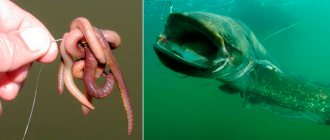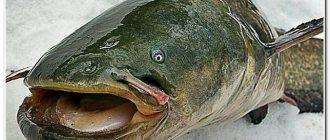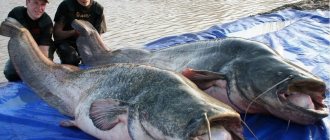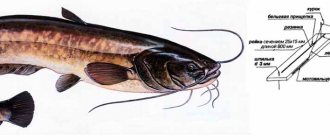Cannibal catfish: legends and reality
The largest fish found in our strip is catfish. In our climate, catfish can reach a weight of 300 kilograms and a length of 5 meters, although there are reports from a century ago about catching catfish over 400 kilograms. However, judging by other sources, both the length and weight of catfish can be much greater. For example, American zoologist David Wheeler in his book Killer Fish names the numbers 6, 3 meters and 500 kg! Sabaneev’s book mentions a unique monument to catfish , installed on Lake Issyk-Kul. The catfish's jaw was installed vertically in the ground in the form of an arch, and its size was such that an adult could pass through it without bending.
German sources mention the capture of a 400-kilogram catfish in 1830 on the Oder River. In Uzbekistan, about 100 years ago, a 430-kilogram specimen was caught.
However, modern fishermen rarely come across catfish larger than 50 kilograms. The catfish spends most of its life at the bottom, in muddy depressions and holes. Catfish feed on fish, crayfish and mollusks, frogs and all kinds of carrion.
Various species of large catfish are found in all regions of the world, but only in our Eastern European part of the country are there true man-eating catfish .
The largest European catfish turns out to be a lover of human flesh, and this has been confirmed historically. Even in the Middle Ages, the catfish was known for the fact that, in addition to its usual food, it was not averse to feasting on sheep and dogs, and sometimes even tasting a gaping bather. A large five-meter catfish can easily swallow a child whole, or drown an adult.
It is quite difficult for a huge catfish weighing several hundred kilograms, which has lived for half a century (and they can live up to 100 years), to provide themselves with regular breakfast, lunch and dinner. Hunting fish is a burden for him. The 50-year-old catfish has speed and strength in abundance, but its maneuverability is not the same. Another thing is prey floating on the surface of the water - ducks, geese, dogs and other four-legged animals that decided to their misfortune to enter the water. And, of course, a person, whose leg is much easier to grab than the same dog. Having tasted the human taste, the catfish, like some African crocodiles, can switch exclusively to such food.
Several years ago, off the island of Khortitsa, at a depth of 15 meters, a tugboat that had disappeared the day before was discovered. There was a huge hole in its side, in which a five-meter catfish was stuck!
When his carcass was raised to the surface and his stomach was opened, everyone present gasped in horror: inside were the remains of three vainly sought Polish tourists, who had recently transferred from the ship in distress to a motor boat, but never made it to the shore.
Local old-timers claim that man-eating catfish have already committed over a dozen attacks on motor and sailing boats. The disappearances of fishing enthusiasts, who preferred fishing further from the shore, have also become more frequent.
www.youtube.com In the Khopyorsky Nature Reserve, in the presence of two rangers, a forester and a senior researcher at a biological station, a catfish attack on a young deer was recorded. In front of eyewitnesses, the voracious predator dragged the poor fellow to the bottom of the lake. Old-timers note that similar cases have happened before.
Here are some historical facts: in 1754, the corpse of a seven-year-old child was found in the stomach of a catfish, in 1558, rings and a human hand were found inside a catfish, in 1790 in Turkey, the corpse of a woman was discovered in a catfish, and a couple of years later, in 1793, in a year The catfish ate two girls. In 1613, a catfish attacked and ate a child, which was confirmed by eyewitnesses.
Of course, it cannot be said that the catfish specifically hunts people. Most likely, he simply finds drowned people and eats them. However, it can be assumed that in many cases of disappearances of people, and especially children, on the river, it is large catfish that are to blame. On the Kuban and Don rivers, there are numerous cases of catfish eating people, as well as the fact that when caught, large catfish bite desperately and can cause serious injury to a person.
Man-eating catfish in history
In the Kokand Khanate, until its liquidation by Russian troops in 1876, an unusual method of execution was used: the condemned person was thrown into a pond with hungry catfish (Silurus glanis).
K. Trionov, who visited the capital of the Khanate, says:
“Khan said that he was very sorry that we were late and did not see him that morning feeding the criminal two huge catfish living in the garden pond. Every Thursday, one of those sentenced to execution is thrown with his legs half-tied into a pond with steep banks opposite the glass gallery of the Khan's harem.
The abandoned person tries to swim across and climb out to the opposite shore of the pool, where there are no guards, but experienced catfish do not sleep and grab the condemned person by the bare legs, trying to pull him into the depths. The unfortunate man, who is promised life if he gets to the shore, fights off these voracious fish, having only his hands free, and the khan and his harem admire this fight, which always ends in the victory of the fish, with laughter.
When Kokand was later taken by the Russians, one of the catfish was still alive, and once a private of the 2nd Turkestan Rifle Battalion, while rinsing his shirt in that pond, was grabbed by the hand by a sneaking catfish, which they did not know about or had forgotten. Fortunately, the soldier escaped with a severe injury to his finger from the teeth of the fish. Now they released the water from the pool and at the bottom, between human bones, lay a fat catfish about a fathom long.
They killed him, and the meat, by order of the commander of the rifle brigade, was distributed to the company kitchens, but, of course, no one ate this fish soup, and after sending test portions to the authorities, it was poured out of the cauldrons.”
(K.K. Trionov. Visiting Khan Nasr-Eddin. Historical Bulletin, 1910, No. 7.)
2.
Cases of attacks on people by large catfish (their weight can reach 200–300 kg, sometimes 400 kg) are also known in natural conditions.
Here is a story about one of these incidents, which also took place in Central Asia in the 19th century (A.K. Gaines. Diary of 1866. Travel to Turkestan).
“As soon as our things arrived [at Fort No. 1], I went for a swim. The policeman who accompanied me with a candle in his hands, which he lit as soon as we left the fortification, explained that he was taking me to the swimming pool of gentlemen sailors, and that it was impossible to swim in the river, otherwise the catfish would drag me away, which happens here quite often. ...
With the greatest pleasure I sank onto the wooden floor of the bathhouse. The fast water of the Syr Darya flowed past with a murmur, and I am deeply grateful to it for washing away the dirt and dust that had accumulated during the painful journey through the Karakum Desert. ...
The Syrdarya is a very good river. It is wide and deep here and abundant with fish of all kinds. ... There are a lot of sturgeons, or rather sturgeons, here. ...
There are even more black fish, which is why they are not valued. There are especially a lot of catfish, the most colossal sizes, so that, in fact, it is dangerous to swim. Recently a battalion of the Samara regiment passed here. People arrived and began to swim.
Suddenly one non-commissioned officer began to scream. Since he was swimming close to the shore, two privates grabbed him by the arms to pull him out, assuming that he was drowning. But the non-commissioned officer, continuing to shout, pulled the soldier with him into the water; finally he began to beg to be thrown, saying that a huge fish had grabbed his leg up to the groin. The soldiers could not hold the unfortunate man.
A few days later, on the shallows far from Kazala, the corpse of a huge catfish, about fourteen pounds in weight, was thrown out, choked by a non-commissioned officer. The monster swallowed one leg up to the groin, but the other was not allowed further by the non-commissioned officer’s body.”
3.
Catfish is the largest fish in central Russia. Despite the fact that these fish have a reputation as scavengers, orderlies of rivers and lakes, they are classic predators who do not disdain eating birds, small domestic animals and even people of suitable build.
According to biologists, in the Russian climate, catfish can reach 300 kg of weight with a body length of about 5 m. And for catfish this is not the limit! From time to time, fishermen and just villagers in different parts of the world talk about larger specimens.
American zoologist David Wheeler, in his book “Killer Fish,” gives the example of a catfish that reached 6.3 m and weighed about 500 kg.
In Germany, local fishermen talk about catching a 400-kilogram catfish in the Oder in 1830. However, officially the largest catfish in Europe was caught in Italy in the spring of 2011. The weight of the fish was a “modest” 114 kg with a really modest length of 2.5 m. The fisherman did not consume the catfish for its intended purpose, but only weighed it, took a few photographs and released it. Before this, the largest catfish that fell into the hands of European fishermen was considered to be a 111-kilogram catfish caught in Spain on the Ebro River.
On May 1, 2009, a catfish weighing 293 kg (the average weight of a cow) and 2.7 m long (one and a half times the height of an adult) was caught on the Mekong River in Thailand. This report can be believed, since the catch was officially recorded not only by the Thai authorities, but also by the head of the international research project World Wildlife Fund.
4.
It would seem, what to fear? Well, big fish get hooked “once every hundred years.” It's not a shark! But no, you need to be afraid.
Firstly, large catfish up to 100 kg in Russian rivers are, if not the norm, then not so uncommon. Secondly, he is interested not only in smaller fish, crayfish, frogs and all kinds of carrion.
Since the Middle Ages, as sources testify, peasants know very well that a catfish can drag a duck, a goose, a dog, and even a sheep to the bottom.
Thirdly, catfish, like the African crocodile, are perfectly camouflaged. (The usual habitat of these fish is a muddy bottom, on which even a large catfish can simply not be noticed.) Fourthly, the mouth of a three-meter catfish can open up to one and a half meters!
Where is there a danger of meeting a bloodthirsty monster? Biologists assure - everywhere! Catfish live in almost all medium and large reservoirs in Russia. They can be found in Europe, Southeast Asia, even in America. Most often, catfish attack at sunset and dawn, so it is at this time that it is recommended to refrain from swimming in unfamiliar bodies of water.
5.
The catfish's habits are very similar to those of a python. He, like a reptile, swallows the entire prey whole and then slowly digests it. The fact that catfish often live up to 100 years old once again emphasizes their adaptability to environmental conditions and excellent skills in obtaining food.
In the last century, when women in rural areas had to manually rinse clothes, men would first check for large catfish in the river. On the Don and Kuban there were cases when large fish snatched underwear from women’s hands, and sometimes attacked them themselves.
Source
River Sinister
Among the freshwater fish that live in Don reservoirs, the catfish stands out especially. Gourmets value it for its delicious, tender meat, and smoked catfish balyk can only be compared in taste to halibut. Perhaps it is for this reason that catfish, along with vymbat and shemaya, are secretly considered a kind of elite among Don fish. The appearance of a catfish inspires, if not fear, then at least a sense of danger.
You especially feel this when you see a large catfish. The color of this fish on top is mostly dark, almost black, while the belly, on the contrary, is light, usually grayish-white. The naked body, completely devoid of scales, makes the catfish incredibly slippery when caught in the hands, and often this very circumstance saves the fish’s life.
Forbidden fish
Since ancient times, a large number of legends and traditions have been associated with catfish. The ancient Slavs considered the catfish to be the “devil horse” of the aquatic, which uses its whiskers as reins. The fear of this huge fish, which supposedly supplies the waterman with drowned people, was connected with this circumstance. That is why catching catfish was strictly prohibited in Rus'.
But there were also rational reasons to be afraid of this fish. Catfish are a real predator. Its main diet consists of freshwater fish. But this primarily applies to small and medium-sized individuals.
It is not easy for a large catfish to feed itself: hunting for small river fish is quite difficult for a catfish, primarily because of its slowness, so even catching a dozen fish in a day is a drop in the ocean for such a freshwater giant.
This is why the catfish has to be a kind of cleaner of the river bottom, sometimes even feeding on drowned people in the depths of the reservoir. Sometimes animals or birds enter the water and, to their misfortune, also become prey to this freshwater predator.
Residents of the Don villages often tell different stories about how, before their eyes, catfish calmly grabbed and swallowed domestic geese and ducks with their huge mouths.
Hunting people?
The principle of catfish hunting is very simple. To do this, the fish just needs to hide in shallow water under some snags, wait for prey, drag it to the depths and drown it. It happens that even a person becomes a victim of a catfish; it is quite easy to grab him by the arm or leg and drag him to the bottom. In addition, catching a defenseless bathing person, especially if it is a child, is not at all difficult for a large catfish.
All lovers of family holidays in nature should not forget about this. It is worth remembering that the catfish is, first of all, a nocturnal hunter who waits for its prey mainly in the morning and evening dawns.
Daytime attacks by catfish on people occur only on very hot days, when large fish come to the surface of the water. On the Don, several attempts by catfish to attack people received wide publicity and caused great public outcry.
Historical facts
Catfish live in almost all large reservoirs of Russia and the CIS countries. Also common in Europe, USA, Canada and Latin America. According to experts, catfish live up to 100 years, reaching 3-4 meters in length, and can attack any living creature on the surface of the water. But unlike a shark, it is not able to tear off a piece of prey - the catfish’s jaw resembles not sharp blades, but a brush with teeth curved back. As a rule, having grabbed the prey, it can no longer let go, and therefore is either forced to swallow it whole, or drag it to the bottom and try to free itself there. That's why
even accidentally grabbing a careless swimmer by the leg, the predator will surely drown him
And although such cases are quite rare, there is documentary evidence of this.
European catfish can reach 3-4 meters in length
For example, ichthyologist Ricciuti, well-known in the world scientific circles, reports on several historically documented facts of catfish attacks on people, references to which he was able to find in the archives of different European countries. So, in 1613, a catfish attacked a baby and ate him, which was proven by witnesses.
In 1754, the corpse of a seven-year-old child was found in the stomach of a large catfish. In 1558, rings and a human hand were discovered inside a large catfish. In 1790, the corpse of a lady was found in a large catfish in Turkey. In 1793, a huge catfish ate two little girls.
There are also more recent cases. So, in the early 80s of the last century, the magazine “Science and Life” published the story of a collective farmer who was grabbed by the leg by a catfish, but he managed to free himself only by literally riddling the fish’s head with a sickle.
In July 1982 in the Khopersky Nature Reserve
in front of the huntsman, forester and researcher at the biological station, the catfish attacked a young deer and pulled him under water
At the end of the summer of 1996, in the village of Kulakovo (Voronezh region of the Russian Federation), a woman and a boy became victims of a man-eating catfish.
In 2015, two fishermen on the Bubr River (Poland) caught a catfish 3.7 m long and weighing 187.5 kg. Inside the fish they found several fragments of a human skull and a metal badge with a Nazi eagle. As experts have established, these
the remains belonged to a German World War II soldier who died many decades ago. Biologists estimate the age of the fish itself to be 90-110 years.
In 2009, a catfish of enormous size frightened residents of the Kazakh city of Aktobe, located on the banks of the Ilek River. Rumors about the existence of a man-eating catfish intensified after three young people drowned in the waters near the Zhilgorod beach. Local residents stated that the catfish that was seen in those places was to blame for their deaths. The townspeople even turned to the authorities with a request to catch the killer fish, but this venture was not crowned with success.
Eyewitness account
Here is what Don fisherman Vladimir Kondratyev said: “That July morning I was fishing not far from the village of Bagaevskaya. Then fishing from the shore obviously didn’t work out, so I had to sail away from the shore in my rubber boat.
After sitting in the boat for about half an hour, I suddenly felt that a large fish was biting. I began to pull the fishing rod towards myself, but the force on the other side was much greater. Such that the fishing rod was torn out of my hands. Suddenly my boat began to rock violently, and then someone completely turned it over, and I found myself overboard.
Then I saw that a huge catfish was coming straight towards me, which turned out to be as tall as me. He bit my hand very painfully, grabbed onto it like a dog, and began to pull me along.
Luckily, I had a hunting knife in my trouser pocket, which I took to gut the caught fish and cook the fish soup over the fire. I grabbed this knife and delivered several random blows to the fish’s face, after which the catfish let me go and disappeared. I barely managed to swim to the shore. The wounded arm had to be treated for a whole week, and the desire to fish further from the shore completely disappeared.”
As for the cases where people allegedly died on the Don due to man-eating catfish, there are no official statistics on this matter.
The only confirmed tragic case in recent years was the story that occurred in the summer of 1996 in the Voronezh region, when a woman and child became victims of a giant fish on the Lower Don.
In the Rostov region, fortunately, such facts have not yet been recorded. However, we should always remember the dangers that each of us may face while relaxing near the water or fishing.
The largest catfish is a cannibal.
Catfish live in almost all large reservoirs of Russia and the CIS countries. They are also common in Europe, but not in northern countries. Can be found in the USA, Canada and Latin America. Experts say that catfish can attack any living creature that is on the surface of the water. A predator always swallows its prey whole.
It cannot tear off pieces like a shark because it does not have teeth as such. The small teeth are more like a brush. At the same time, catfish, which can live up to 100 years, are sometimes unable to provide themselves with a regular breakfast. Therefore, it is easier for him to find prey on the surface: ducks, birds, dogs and even people.
China Every year, swimmers mysteriously disappeared in one of the Chinese reservoirs. The mystery of the disappearances has already been revealed. It turned out that in the reservoir there was a three-meter catfish with a head more than a meter. Human remains were found inside the fish.
Catching a big catfish in Holland In one of the lakes at the Centerparcs holiday park in Holland, a 2.3-meter catfish is kept at bay. They called him Big Momma. It feeds mainly on ducks that swim into the lake. According to park staff, a catfish can eat 2-3 birds per day. In addition, the fish has several small and large dogs on its account.
Man-eating catfish (4 photos + 1 video)
River monsters are increasingly attacking poultry, livestock and even people
Scientists are sounding the alarm: due to the inevitably changing environmental situation, the behavior of these giants is increasingly becoming unpredictable. They certainly don't look like sharks or crocodiles. However, catfish are predators, and there is something to think about here.
Unpredictable killer fish
Catfish live up to a hundred years and are very adapted to the conditions in which they live. However, along with their sanitary activities of eating drowned animals and sick fish, catfish often become killers. Surely, in the minds of most city dwellers, this type of fish is small in size, and most often for people they are just aquarium catfish. But experienced fishermen, of course, know what a difficult task it is to pull this huge monster with a terrible grin out of the river waters. Indeed, catfish are the largest waterfowl in our area. Moreover, these huge fish pose a serious threat not only to small animals and birds, but also to people.
Freshwater giants love quiet bodies of water. It is in such places that fishermen most often meet them. In Kazakhstan, for example, several years ago, one of these catfish was caught in the Kapchagai reservoir, 2 meters 74 centimeters in length, and its weight was more than a hundredweight. In Russian conditions, some of the catfish representatives can weigh as much as three hundred kilograms, and their body length reaches four or even five meters. Often fishermen saw catfish that were much larger in size. There is even a monument to such a giant in Issyk-Kul. Moreover, it represents the natural mouth of a huge catfish, placed in the form of an arch, under which anyone can easily and freely pass - it is so huge. The book by US zoologist David Wheeler, which talks about killer fish, describes a real-life catfish, the length of which reached more than six meters, and it weighed half a ton. Fish of approximately the same weight were caught at different times by German and Uzbek fishermen.
Catfish is a cannibal, do catfish attack people?
Catfish is the largest predator belonging to the freshwater family .
Its habitats are whirlpools and littered river pits, its weight can reach 300 kg, and its height with this weight can be up to five meters. But it reaches such large sizes at the age of about 100 years. Anglers come across fish up to 20 kg. The predator has a huge blunt head and a large mouth. Two long whiskers extend from the mouth and four whiskers are located on the chin. With the help of his whiskers, he finds food in the dark; the whiskers serve him as tentacles. With such large dimensions, the fish has very small eyes, its tail is long and unlike a fish. The color of the predator is closer to black on top, and the belly is off-white. The body has no scales.
River hunter attacks from ambush
Anyone can observe scary fish with their own eyes when they find themselves in Kazakhstan near the Ilek River. An official ban on swimming has been introduced there precisely because of the habitat of large catfish in these waters. The whole reality of the threat to life while swimming in this river is easy to imagine if you remember the incident that occurred in a reservoir in Voronezh about fifteen years ago, when a giant catfish attacked a girl and a child.
Many eyewitnesses who have observed huge fish are not even at all surprised by such stories. For example, residents of Khabarovsk cannot forget an incident that occurred in their area in the mid-60s of the last century. Then the giant catfish attacked the little boy and dragged him under the water. Enraged residents tried for a long time to catch this monster, but they never succeeded. And only thanks to the military, who responded to the population’s request to help them catch the catfish, the fish was tracked down and shot with machine guns.
The favorite method of hunting for catfish is an ambush attack. Usually a giant monster pounces on the victim from below and drags him into the depths. A similar story once appeared in the Ukrainian media. At a 15-meter river depth near the island of Khortitsa, divers found a sunken ship and a huge catfish five meters long stuck in its hole. When the fish was opened, the remains of three passengers of this ship were removed from its insides, all of them were citizens of Poland. However, this fact did not come as a surprise to the local population. According to the stories of residents of those areas, toothy monsters attack people every now and then and have attacked fishing boats more than once.
Catfish attack
When you go to Kazakhstan, you can see huge fish yourself. There is an official ban on swimming due to the presence of large catfish in the water.
This threat is quite real, because cases often arise when huge catfish attack people. Eyewitnesses and those who saw this on video are not surprised. In the 60s of the 20th century, on the territory of Khabarovsk, a huge catfish attacked a boy and pulled him under water. People were worried that the fish might eat the child, so the decision was made to catch the catfish. This was done by the military, who tracked down the fish and shot it with machine guns.
It is believed that such a predator prefers to attack from ambush . As a rule, it quickly moves towards its victim from below, after which it drags it into the depths. A similar story could be found in the Ukrainian media. Thus, near the island of Khortitsa, at a depth of 15 m, a sunken ship was found, in one of the holes of which a catfish 5 m long was stuck. After opening the body of the fish, the remains of 3 people were discovered. The local population was not surprised by the story about the cannibal catfish. There are eyewitnesses here who have more than once observed live or on video catfish attacks on fishing boats.
Lipetsk monster
One such water monster appeared some time ago in the waters of the Lipetsk Sea (a large local reservoir). According to the stories of many eyewitnesses, it was indeed a real monster of incredible size. It ruled this reservoir with complete impunity and brazenly: it devoured the local game and domestic animals, including dogs. And one day, local resident Evgenia Mulemina brought her pet, a piglet named Yasha, to the water. He began to swim, because he really loved splashing in the water. According to the woman, this time Yasha did not want to go ashore. Then she began to approach him to take the piglet out of the water. And at that moment, right in front of her, something huge with a splash emerged for a moment to the surface and immediately grabbed the pig. Yashka screamed and disappeared along with the monster under the water.
Dangerous scavengers
Similar unusual fish live in the rivers of Thailand. For example, in the Mekong they caught an almost three-meter catfish that weighed almost 300 kilos. Since this catch was officially recorded at the state level, this catfish was recognized as the world's largest giant among fish living in fresh water bodies.
And the fears seem to be unfounded. Just think, in the reservoirs of our planet, someone happens to encounter huge fish once or twice a hundred years. After all, they are most likely completely harmless to people. After all, these are not crocodiles, but catfish. But everything is not as rosy as it seems at first glance. Firstly, the probability of meeting such a giant in muddy domestic river waters is not so small. The presence of one hundred kilogram whiskered creatures in Russian rivers is almost commonplace. Catfish love to bury themselves in silt, and therefore they are not even noticeable in the water. But back in the Middle Ages, villagers were well aware of all the dangers that such huge, toothy creatures could pose. And it was not only domestic animals, sheep and dogs that came to drink and swim that became victims of giant killer fish. Sometimes people can find themselves in the mouth of a monster catfish.
Fishermen who have ever encountered such a serious catch talk about how difficult it is to pull a large catfish out of the water; it can cause serious injuries.
In ancient times, before women began the process of washing and rinsing clothes in the river, their husbands always inspected the pond to make sure that there were no large catfish in it. But there were also attacks by ferocious fish. Huge long-moustached creatures suddenly emerged from the water and attacked the women. Typically, catfish hunt for prey in the early hours of the day or in the evening. So it is better not to swim in unfamiliar rivers in the morning and towards sunset.
Although, for the most part, catfish are scavengers and eat already dead organisms, nevertheless, it is worth being careful! Where might danger lie? Geographically, the habitats of large catfish are quite wide. They are found in almost any fresh water, both in our country and in the near and far abroad. For example, a catfish, whose body length is two meters, still swims in the lake of the Dutch park today. The giant feeds on the ducks that live there and even stray dogs that decide to go into the water on a hot day to cool off. Therefore, when deciding to swim in some unfamiliar body of water, be careful!
Myths of the Dnieper: a rare bird, a man-eating catfish and thousands of victims
The ancient Greeks called this river Borysthenes, the Slavs - Slavutich, the Scythians, and then the Romans - Danapris. It was on its banks that the ancient Russian capital Kyiv was located. It is the fourth in length and third in area among European rivers and the main waterway of Ukraine. About 70% of Ukrainians use Dnieper water. Most Ukrainian rivers flow into the Dnieper.
True myths of the Black Sea. Gourmet paradise, home of the police and an important staging area
Over the entire history of its existence, such a river simply could not help but acquire legends and myths. The publication Ukraina.ru recalls the most common of them.
Rare bird and wonderful blue
Speaking about the Dnieper, many residents of the post-Soviet space can recite by heart an excerpt from Nikolai Gogol’s “Terrible Vengeance.”
“A rare bird will fly to the middle of the Dnieper,” he wrote in a story first published in 1832.
Of course, this is an exaggeration. Birds are able to overcome the water spaces of the Dnieper, including not very rare ones. Take, for example, such a migratory bird as a wild goose. The story about the journey of an ordinary Swedish schoolboy Nils with these birds has long been a favorite not only among Swedish, but also among Soviet schoolchildren.
According to data from the German Bird Conservation Committee, geese wintering in Hungary regularly cross the Dnieper. Pedantic German researchers even have maps that confirm this: the Germans, engaged in the study of white-fronted, gray geese, bean gooses and lesser white-fronted geese, ringed their charges, also attaching GPS navigators to them. The data obtained indicate that geese cross the Dnieper even near Cherkassy - where the Kremenchug reservoir is located - the largest of all the Dnieper reservoirs.
© screenshot from blessgans.de
we also owe another misconception about the Dnieper to Gogol, as well as to the painter Arkhip Kuindzhi
“Blue, blue, he walks in a smooth flow and in the middle of the night, as in the middle of the day; visible as far as the human eye can see,” Gogol wrote in the same “Terrible Revenge.”
And Kuindzhi in 1901 in his painting “Dnieper” depicted this river as sky blue.
Alas, today the Dnieper can be painted in completely different colors.
“Life is a traffic light. You can drive on red, yellow or green,” Dnieper Mayor Boris Filatov and posted a photo of the Central Bridge open after repairs.
The yellow and red ones in the photo were the waterproofing of the bridge. But green is the Dnieper River itself. The publication Ukraina.ru also wrote about the reasons for its greening.
Man-eating catfish
Dozens of articles have been written about him, videos dedicated to him collect millions of views, children are frightened by him, someone from your circle has definitely seen him in person (as a rule, this is the brother of his best friend’s godfather’s wife).
After the Dnieper was blocked with dams and Dnieper reservoirs appeared, and one of the queens of the river - the beluga - was caught almost entirely by fishermen, it was he who became the absolute owner of the Dnieper depths and the largest fish of the main Ukrainian river.
Farewell to the Dnieper. The main river of Ukraine is in danger of disappearing
©
press service of Khersonfishery protection
Vladimir Dal wrote in his book “On Beliefs, Superstitions and Prejudices of the Russian People” , they “don’t eat it because <...> it’s a damn horse; This fish is fatty, not tasty and not healthy, except for the rune that goes into the pie.” But he himself, if you believe modern myths, may well eat you.
We are talking about a catfish, and not a simple one, but a cannibal catfish. In principle, the very size of this fish, as well as its habits - sometimes a catfish can feast on a bird gaping on the surface of the water - gave rise to such rumors.
After the accident at the Chernobyl nuclear power plant, one of the popular rumors was that radioactive sludge settled at the bottom of the Kyiv reservoir, and later the entire Dnieper. This is not surprising, because the Pripyat River, on the banks of which the Chernobyl Nuclear Power Plant is located, flowed into the “Kiev Sea” along with the Dnieper. And before the accident, experienced fishermen and underwater fishing enthusiasts met old large catfish at the bottom of the reservoir. Sometimes, especially at night, they could even snatch an underwater gun shining in the light of a lantern or tear off a fin from a scuba diver’s leg, mistaking it for a large fish. And then rumors began to spread about radioactive sludge, and the Dnieper catfish began to grow rapidly in the popular consciousness. And with this, their expected diet also changed.
If earlier not everyone believed that a catfish could grab a gaping duck, now no one doubted: a large catfish, if desired, will feast on a person.
However, there is still no evidence of catfish hunting humans (and not vice versa). Catching a catfish over one and a half meters long is a rare success. Although in the 19th century it was possible to meet larger catfish.
Chernigov: ancient Russian capital and Ukrainian military Las Vegas
“Our largest catfish are found, or rather, were found, it seems, in the Dnieper, where, according to Kessler, a catfish was caught (in the fifties) that was more than 4 m long and weighed 288 kg,” he wrote in his book “Fishes of Russia. Life and catching of our freshwater fish,” published in 1875, Russian zoologist Leonid Sabaneev .
By the way, in the same book he wrote that catfish “drown swimming dogs, even calves, and there are several examples of large catfish dragging bathing children into the water and drowning them.”
However, modern ichthyologists claim: if a catfish attacks a person, it is only for the purpose of self-defense and protection of offspring, and not in search of food: the catfish has too small a throat to swallow large prey. And the available video footage shows that a large catfish is more likely to be afraid of a person than to attack him.
But all this does not stop the media from regularly scaring people with stories about cannibalistic catfish. In 1991, for example, residents of Zaporozhye were excited by the republican newspaper “Komsomolskoe Znamya”, which published the article “Dnieper killers: they turned out to be cannibal catfish.”
The article told about a sudden night accident near Zaporozhye on the liner "Evgeniy Vuchetich": a leak was discovered there, and the ship was forced to anchor. Four passengers were transferred from it to a motor boat, but they never made it to Zaporozhye, having gone missing.
“The motorboat was soon discovered: a large hole was gaping in its stern, traces of blood were visible,” the authors of the article reported.
They also said that a year later, divers from the local club “Aquanaut” at the northern tip of the island of Khortitsa at a depth of 15 meters discovered the tugboat BT-313, which had disappeared the day before.
“A giant catfish was stuck in a hole in the side. When the catfish was raised to the surface and measured, they gasped: its length was almost five meters, its weight was 355 kilograms. The remains of three people were found in the giant's stomach. It turns out that at night these monsters lie down in deep holes, and in the morning they go out hunting. Last year, about a dozen attacks on motor and sailing boats were recorded. The mysterious disappearance of ice fishermen, apparently, should also be attributed to killer catfish,” the authors of the article confidentially reported.
The resonance in Zaporozhye was great. As a result, local journalists found the authors, or rather the author. One person was hiding under two pseudonyms - an engineer at one of the local research institutes, Viktor Korolev . He explained that he wrote the article out of anger at the press: they, according to him, believed that everything was allowed to them. For example, the same “Komsomolskoe Znamya” published an article about huge rats, which everyone believed. “I felt offended that people believed such fables, so I composed my own,” Korolev explained.
Despite the exposure of the story, even today “sharks of the pen” sometimes remember an old acquaintance. It’s time to change the words in the unofficial anthem of Russian and Ukrainian journalism - the song “The Man-Eating Horse”, especially since the meaning of the song will not change. And the man-eating catfish is still found in the media more often than its artiodactyl companion on the diet.
Jewels at the bottom
It is unlikely that the chronicler who worked on “The Tale of Bygone Years” could have thought that thanks to him, the Dnieper would be enriched with another legend.
“And Volodymer began to reign in Kiev as one, and placed idols on the hill outside the palace courtyard: Perun was made of wood, and his head was silver, and his mustache was gold, and Khars Dazhbog and Stribog , and Semargl and Mokosh ,” the chronicler described the beginning of the reign of the future baptist of Russia - Prince Vladimir .
Sigismund von Herberstein , who lived in the 15th-16th centuries , who translated “gold mustache” into German as the name of the unknown Slavic deity Uslad, but also of many modern Ukrainians. In the 90s, in the schools of young independent Ukraine, some history teachers talked about how the cunning Japanese suggested that the Ukrainian authorities clean up the Dnieper. With one condition: everything they find in the river during cleaning, they will take for themselves. The young Ukrainian democracy acted according to the old saying: “I don’t make noise myself and I won’t give it to anyone else.”
“This is not without reason!” - the teachers explained to the schoolchildren, reminding them of the idols standing near the prince’s palace.
They say that when Vladimir baptized Rus', these idols were thrown from the Dnieper steeps into the river. The idol of Perun thrown into the river - the same one with a silver head and a golden mustache - could not surface for a long time. Supporters of the old faith ran along the shore and shouted: “Go out, God, go out.” As a result, he “gave up.” Now “folk linguistics” is arguing about the meaning of this verb: someone claims that it means to emerge, to emerge, and others - that it means to swim out. Be that as it may, the place next to which the idol “kicked out” was called Vydubichi. In the second half of the 11th century, the Vydubitsky Monastery appeared there. Now this is an area near the city center.
But the main thing is different: the legend claims that the idol (and popular rumor expanded and supplemented its chronicle description, rewarding it with ruby lips and other precious decorations) even now lies in the thickness of the Dnieper silt. And whoever finds it will become fabulously rich.
This legend is still alive today. And no one is embarrassed by the fact that the bottom of the Dnieper near Vydubychi and downstream has already been dug up. True, not by archaeologists or treasure hunters, but by dredgers of illegal sand miners. And in some places in that area, the bottom of the Dnieper has risen so much that new islands will appear there any day now.
Non-existent hundred thousand victims
Increasingly, a funeral candle appears in the corner of Ukrainian television screens. Under President Petro Poroshenko, they even celebrated the 300th anniversary of the capture of Baturyn by tsarist troops. If Poroshenko had won the election, there is no doubt that in 2021, on August 18, another candle would be burning in the corner of Ukrainians’ television screens, marking 80 years since an event that never happened.
Back in 2021, Poroshenko-owned Channel 5 released a mourning video.
“On August 18, 1941, the Soviet government blew up the Dnieper hydroelectric power station dam without warning and evacuation of people. About 100,000 Ukrainians and many Soviet soldiers died. But this did no harm to the Nazis. This is another terrible crime of the NKVD of the USSR,” the captions read.
However, Channel 5 was not original. Long before the Maidan, the “1+1” TV channel, owned by the oligarch Igor Kolomoisky , released a “documentary” called “Secrecy Level 18.” It talked about the study of secret documents of the 157th NKVD regiment, which testified to the explosion of the dam and the terrible casualties that followed it.
“Giant whirlpools cut off and literally sucked in the cavalry corps and two Soviet combined arms armies, which were already retreating. Only disunited groups were able to swim out, which were then besieged and captured. The wave hit the coastal strip and a column of refugees,” the voice-over described the horrors of the tragedy.
At the same time, it was argued that the sappers’ mistake played a big role in what happened: no one expected that the breach would be so large.
However, “1+1” was not the first to talk about the “Zaporozhye tsunami”. Back in 2001, the newspaper Fakty reported on this tragedy. True, then the article spoke about the death of “hundreds of Red Army soldiers and residents of Khortitsa.”
“The units of Soviet troops accumulated in the floodplain part of the island of Khortitsa were not warned about the upcoming explosion and its possible disastrous consequences. The water gushing from the upper pool through a break in the dam rose up in a 20-meter wave of unprecedented force. Part of the water that swept along the bed of the lower Dnieper fell on the island, on armed people, but defenseless against the elements. When the wave went away, hundreds (if not thousands) of soldiers were left hanging on willows, elms and oaks in unnatural positions,” local historian Konstantin Sushko .
However, since 2001, the height of the wave has also increased - now they write about 30 meters, and the number of dead soldiers, who have already been united into two armies and one cavalry corps.
For a professional historian, the information posted by such seemingly serious publications as Radio Liberty will cause hysterical laughter.
By the beginning of the Great Patriotic War, the Red Army had four cavalry corps, two divisions in each. One of them also had a mountain cavalry division. In general, there would be no way to hide the death of one of the four cavalry corps. Some sources even name the number of the dead corps - the 2nd, whose first commander was Grigory Kotovsky . And everything would be fine, but in the fall this corps, although thinned out in battles, fought near Belgorod and Korocha, and in early November it was transferred from the Novy Oskol area to Moscow.
As for the armies, the defense of Zaporozhye was held by the 18th Army. She also took part in the Donbass-Rostov strategic defensive operation, which began on September 29, 1941. Together with it, another army took part there, which is called destroyed by the “Dnieper tsunami” - the 9th, which was surrounded on August 13 near Nikolaev. By the way, it was in its composition that the 2nd Cavalry Corps was located.
"Captain's bridge between Pikul and Dybenko." How an officer who served in “Red St. Petersburg of Ukraine” influenced Russian literature
A physicist will also laugh at this legend of the Dnieper, who knows that in order for a 30-meter wave to form in the Dnieper, the entire Dnieper Hydroelectric Power Station dam, which, by the way, began releasing water a day before the explosion, would have to disappear overnight.
In general, no tsunami, no gigantic whirlpools swallowing up corps and divisions. And most importantly - no photographic or video evidence, which is strange, given the full power of the propaganda of the Third Reich. It would seem, pick up a camera and make a movie about the atrocities of Bolshevism. But even Goebbels’ propagandists did not have such a film. But the story of hundreds of thousands of dead appeared in independent Ukraine.
What can I say? The Dnieper is great, rolling its waters across Ukraine, and there are an innumerable number of fairy tales and legends, and sometimes downright crazy tales that tell about this mighty river.











